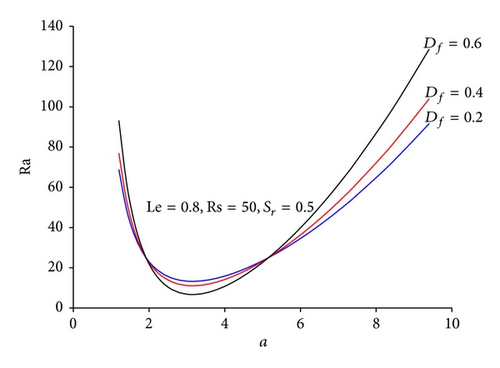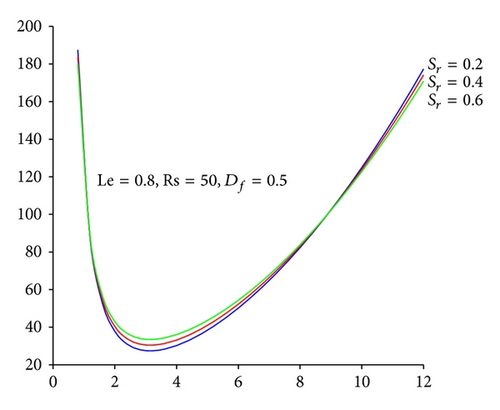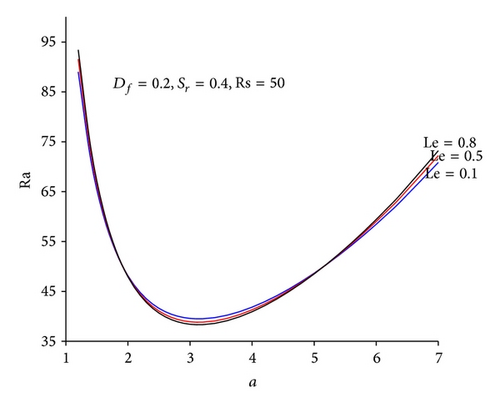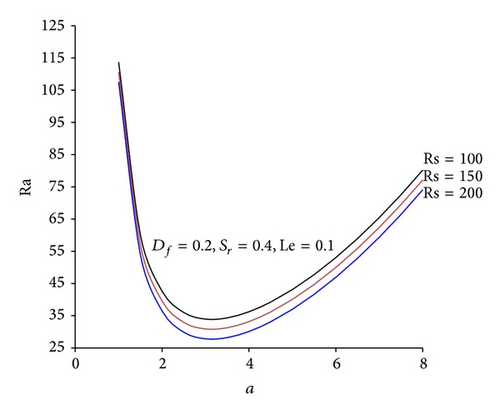Double Diffusive Convection in a Layer of Maxwell Viscoelastic Fluid in Porous Medium in the Presence of Soret and Dufour Effects
Abstract
Double diffusive convection in a horizontal layer of Maxwell viscoelastic fluid in a porous medium in the presence of temperature gradient (Soret effects) and concentration gradient (Dufour effects) is investigated. For the porous medium Darcy model is considered. A linear stability analysis based upon normal mode technique is used to study the onset of instabilities of the Maxwell viscolastic fluid layer confined between two free-free boundaries. Rayleigh number on the onset of stationary and oscillatory convection has been derived and graphs have been plotted to study the effects of the Dufour parameter, Soret parameter, Lewis number, and solutal Rayleigh number on stationary convection.
1. Introduction
Bénard convection originated from the experimental works of Bénard [1] and theoretical analysis of Lord Rayleigh [2]. Lord Rayleigh studied the dynamic origins of convective cells and proposed his theory on the buoyancy driven convection. The detailed study of Bénard convection in Newtonian fluid in nonporous medium under varying assumptions of hydrodynamics and hydromagnetics had been given by Chandrasekhar [3]. Lapwood [4] had studied the stability of convective flow in hydromagnetics in a porous medium using Rayleigh’s procedure. The Rayleigh instability of a thermal boundary layer in flow through a porous medium had been considered by Wooding [5]. McDonnel [6] suggested the importance of porosity in the astrophysical context.
Double-diffusive convection is referred to buoyancy-driven flows induced by combined temperature and concentration gradients. The onset of double diffusive convection in a fluid saturated in porous medium is regarded as a classical problem due to its wide range of applications in many engineering fields such as evaporative cooling of high temperature systems, agricultural product storage, soil sciences, enhanced oil recovery, packed-bed catalytic reactors, and the pollutant transport in underground. A detailed review of the literature concerning double diffusive convection in binary fluid in a porous medium was given by Nield and Bejan [7], Trevisan and Bejan [8], and Malashetty and Kollur [9]. Thermal convection in binary fluid driven by the Soret and Dufour effects had been investigated by Knobloch [10] and showed that the equations were identical to the thermosolutal problem except relation between the thermal and solutal Rayleigh numbers. The above literature dealt with Newtonian fluids.
The study of natural convection of non-Newtonian fluids in a porous medium had gained much attention because of its engineering and industrial applications. These applications included design of chemical processing equipment, formation and dispersion of fog, distributions of temperature and moisture over agricultural fields and groves of fruit trees, and damage of crops due to freezing and pollution of the environment.
The fluids that show distinct deviation from “Newtonian hypothesis” (stress on fluid is linearly proportional to strain rate of fluid) are called non-Newtonian fluids. Different models had been proposed to explain the behavior of non-Newtonian fluids. Maxwell model is one of them. These fluids help us to understand the wide variety of fluids that exist in the physical world and characterized by power-law model. The work on viscoelastic fluid appears to be that of Herbert on plane coquette flow heated from below. He found a finite elastic stress in the undistributed state to be required for the elasticity to affect the stability. Using a three constants rheological model due to Oldroyd [11], the author demonstrated, for finite rate of strain, that the elasticity has a destabilizing effect, which results solely from the change in apparent viscosity.
The importance of the study of viscoelastic fluids in a porous medium has been increasing for the last few years. This is mainly due to their applications in petroleum drilling, manufacturing of foods and paper, and many others. The problem of convective instability of viscoelastic fluid heated from below was first studied by Green [12]. Vest and Arpaci [13] investigated problems of overstability in a horizontal layer of a viscoelastic fluid heated from below. Bhatia and Steiner [14] studied the problem of thermal instability of a Maxwellian viscoelastic fluid in the presence of rotation and found that rotation has a destabilizing influence in contrast to its stabilizing effect on a viscous Newtonian fluid. Bhatia and Steiner [15] have also studied the thermal instability of a Maxwellian viscoelastic fluid in hydromagnetic and found that magnetic field had stabilizing effect on the Maxwell fluid, just as in the case of Newtonian fluid. Sharma and Kumar [16] studied the Hall effect on thermosolutal instability in a Maxwellian viscoelastic fluid and found that Hall effect destabilizes the fluid layer while Kirti and Chand [17] studied the combined effect Hall Current, suspended particles, and variable gravity in a layer of Maxwell viscoelastic fluid. Chand and Kango [18], Chand [19–21], and Chand and Kumar [22] studied problems of thermal instability of Maxwell viscoelastic fluid in porous medium under various assumptions. Chand and Rana [23] investigated the Dufour and Soret effects in layer of elasticoviscous fluid in a porous medium and found that Dufour parameter destabilizes the fluid layer while Soret parameter has both the stabilizing and destabilizing effects on fluid layer depending upon certain conditions.
In this paper an attempt has been made to study the Dufour and Soret effects on the onset of instability in a horizontal layer of Maxwell viscoelastic fluid in a porous medium.
2. Mathematical Formulations of the Problem
Consider an infinite horizontal layer of Maxwell viscoelastic fluid of thickness “d,” confined between the planes z = 0 and z = d in a porous medium of porosity ε and medium permeability k1 and is acted upon by gravity g(0, 0, − g). This layer of fluid is heated and soluted in such a way that a constant temperature and concentration distribution is prescribed at the boundaries of the fluid layer. The temperature (T) and concentration (C) are taken to be T0 and C0 at z = 0 and T1 and C1 at z = d, (T0 > T1, C0 > C1). Let ΔT and ΔC be the difference in temperature and concentration across the boundaries.
Let q(u, v, w), p, ρ, T, C, α, α′, μ, κ, and κ′ be the Darcy velocity vector, hydrostatic pressure, density, temperature, solute concentration, coefficient of thermal expansion, an analogous solvent coefficient of expansion, viscosity, thermal diffusivity, and solute diffusivity of fluid, respectively.
2.1. Assumptions
- (i)
Thermophysical properties expect for density in the buoyancy force (Boussinesq hypothesis) are constant.
- (ii)
Darcy’s model with time derivative is employed for the momentum equation.
- (iii)
The porous medium is assumed to be isotropic and homogeneous.
- (iv)
No chemical reaction takes place in a layer of fluid.
- (v)
The fluid and solid matrix are in thermal equilibrium state.
- (vi)
Radiation heat transfer between the sides of the wall is negligible when compared with other modes of the heat transfer.
2.2. Governing Equations
2.3. Steady State and Its Solutions
2.4. Perturbation Solution
Ra = gρ0αk1ΔTd/μκ is the thermal Rayleigh number, Rs = gρ0α′k1ΔCd/μκ′ is the solutal Rayleigh number, Le = κ/κ′ is the Lewis number, F = (κ/σd2)λ is the stress relaxation parameter, Df = DTCΔC/κΔT is the Dufour parameter, and Sr = DCTΔT/κΔC is the Soret parameter.
3. Normal Modes and Stability Analysis
The critical cell size at the onset of instability is obtained from the condition , which gives ac = π.
This result is the same as obtained by Lapwood [4] for Newtonian fluid.
4. Result and Discussion
The onset of double diffusive convection in a horizontal layer of Maxwell viscoelastic fluid in the presence of Soret and Dufour in a porous medium is investigated analytically and graphically. The expressions for both the stationary and oscillatory Rayleigh numbers, which characterize the stability of the system, are obtained analytically. The stationary critical Rayleigh number is found to be independent of the viscoelastic parameter F; thus Maxwell viscoelastic binary fluid behaves like ordinary Newtonian binary fluid. The stationary critical Rayleigh number and critical wave number are independent of viscoelastic parameter because of the absence of base flow in the present case. The computations are carried out for different values solutal Rayleigh number Rs, Soret parameter Sr, Dufour parameter Df, and Lewis number Le. The parameters considered are in the range of 102 ≤ Ra ≤ 105 (thermal Rayleigh number), 102 ≤ Rs ≤ 103 (solutal Rayleigh number), 0 ≤ Sr ≤ 1 (Soret parameter), 0 ≤ Df ≤ 1 (Dufour parameter), [24, 26], and 10−2 ≤ Le ≤ 1 (Lewis number) [27, 28], [29]. We choose the values of Dufour parameter Df and Lewis number Le in such a way that DfLe ≠ 1.
In order to investigate effects of the Dufour parameter Df, Soret parameter Sr, Lewis number Le, and solutal Rayleigh number Rs on stationary convection, we examine the behavior of ∂Ra/∂Df, ∂Ra/∂Sr, ∂Ra/∂Le, and ∂Ra/∂Rs analytically.
- (i)
()
- (ii)
()
- (iii)
()
- (iv)
()
Now we discussed the effects of various parameters on the onset of double diffusive convection of Maxwell viscoelastic fluid in a porous medium for stationary convection graphically. The convection curves for solutal Rayleigh number Rs, Soret parameter Sr, Dufour parameter Df, and Lewis number Le in the (Ra, a) plane are shown in Figures 1–4.




Figure 1 shows the variation of stationary Rayleigh number with wave number for different values of Dufour parameter and it is found that the Rayleigh number first increases then decreases and finally increases with increase in the value of Dufour parameter; thus for stationary convection Dufour parameter has both the stabilizing and destabilizing effects depending upon certain conditions.
Figure 2 shows the variation of stationary Rayleigh number with wave number for different values of Soret parameter and it is found that the Rayleigh number first decreases then increases and finally decreases with increase in the value of Soret parameter; thus for stationary convection Soret parameter has both the stabilizing and destabilizing effects depending upon certain conditions.
Figure 3 shows the variation of stationary Rayleigh number with wave number for different values of Lewis number and it is found that the Rayleigh number first increases then decreases and finally increases with increase in the value of Lewis number; thus for stationary convection Lewis number has both the stabilizing and destabilizing effects depending upon certain conditions.
Figure 4 shows the variation of Rayleigh number with wave number for different value of the solutal Rayleigh number Rs and it is found that the Rayleigh number decreases with increase in the value of solutal Rayleigh number Rs; thus solutal Rayleigh number Rs has destabilizing effect on the stationary convection.
Curves in Figures 1–3 intersect two specific values of wave number a which is independent of Lewis number Le and Soret parameter Sr as explained in the analytical part of the results and discussion.
5. Conclusions
A linear stability analysis of double diffusive convection in a horizontal layer of Maxwell viscoelastic fluid in the presence of Soret and Dufour in a porous medium is investigated analytically and graphically. The expressions for both the stationary and oscillatory Rayleigh numbers, which characterize the stability of the system, are obtained.
- (i)
In stationary convection Maxwell viscoelastic fluid behaves like ordinary Newtonian fluid.
- (ii)
Dufour parameter, Soret parameter, and Lewis parameter have both stabilizing and destabilizing effects on the stationary convection.
- (iii)
Solutal Rayleigh number destabilizes the stationary convection.
- (iv)
In limiting case when Rs = Sr = Df = 0 the critical thermal Rayleigh number obtained is the same as reported by Nield [25].
Nomenclature
-
- a:
-
- Wave number
-
- C:
-
- Solute concentration
-
- cp:
-
- Heat capacity
-
- Df:
-
- Dufour parameter
-
- DTC:
-
- Dufour coefficient
-
- DCT:
-
- Soret coefficient
-
- d:
-
- Thickness of fluid layer
-
- F:
-
- Stress relaxation parameter
-
- g:
-
- Acceleration due to gravity
-
- k1:
-
- Medium permeability
-
- Le:
-
- Lewis number
-
- n:
-
- Growth rate of disturbances
-
- p:
-
- Pressure
-
- q:
-
- Darcy fluid velocity
-
- Ra:
-
- Thermal Rayleigh number
-
- Rac:
-
- Critical Rayleigh number
-
- Rs:
-
- Solutal Rayleigh number
-
- Sr:
-
- Soret parameter
-
- t:
-
- Time
-
- T:
-
- Temperature
-
- (u, v, w):
-
- Components of fluid velocity
-
- (x, y, z):
-
- Space coordinates.
-
- Greek Symbols
-
-
- ρ:
-
- Density of fluid
-
- α:
-
- Coefficient of thermal expansion
-
- α′:
-
- Analogous solvent coefficient of expansion
-
- μ:
-
- Viscosity
-
- κ:
-
- Thermal diffusivity
-
- κ′:
-
- Solute diffusivity
-
- λ:
-
- Relaxation time
-
- ∂:
-
- Curly operator
-
- ε:
-
- Porosity
-
- ω:
-
- Dimensionless frequency of oscillation
-
- σ:
-
- Thermal capacity ratio.
-
- Superscripts
-
-
- ′:
-
- Nondimensional variables
-
- ′′:
-
- Perturbed quantity.
-
- Subscripts
-
-
- 0:
-
- Value of variables at lower boundary
-
- 1:
-
- Value of variables at upper boundary
-
- s:
-
- Steady state
-
- f:
-
- Fluid
-
- m:
-
- Porous medium.
Conflict of Interests
The authors declare that there is no conflict of interests regarding the publication of this paper.
Acknowledgment
The authors are grateful to the reviewers for their lucid comments and suggestions which have served to improve the research paper.




